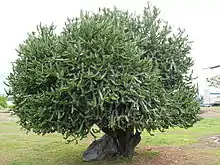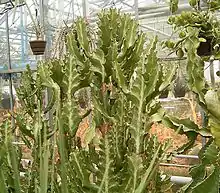Euphorbia lactea
Euphorbia lactea is a species of spurge native to tropical Asia, mainly in India.[1]

| Euphorbia lactea | |
|---|---|
 | |
| Scientific classification | |
| Kingdom: | Plantae |
| Clade: | Tracheophytes |
| Clade: | Angiosperms |
| Clade: | Eudicots |
| Clade: | Rosids |
| Order: | Malpighiales |
| Family: | Euphorbiaceae |
| Genus: | Euphorbia |
| Species: | E. lactea |
| Binomial name | |
| Euphorbia lactea | |
It is an erect shrub growing up to 5 metres (16 ft) tall, with succulent branches 3–5 centimetres (1.2–2.0 in) diameter, ridged, with a triangular or rhombic cross-section; the ridges are spiny, with short spines up to 5 millimetres (0.20 in) long. The leaves are minute, and soon deciduous.[1] All parts of the plant contain a poisonous milky latex.[2] Common names include mottled spurge,[3] frilled fan, elkhorn, candelabra spurge,[3] candelabrum tree, candelabra cactus, candelabra plant, dragon bones,[3] false cactus,[3] hatrack cactus,[3] milkstripe euphorbia, mottled candlestick.
It is used medicinally in India.[4] It is widely grown as an ornamental plant, both in the tropics, and as a houseplant in temperate regions; a number of cultivars have been selected for ornamental use, notably 'Cristata' with frilled branching.[1][5]
References
- Huxley, A, ed. (1992). New RHS Dictionary of Gardening. ISBN 0-333-47494-5
- Poisonous plants: Euphorbia lactea Archived 2009-06-03 at the Wayback Machine
- "Euphorbia lactea". Germplasm Resources Information Network (GRIN). Agricultural Research Service (ARS), United States Department of Agriculture (USDA). Retrieved 16 January 2018.
- Plant of the Week.org Euphorbia lactea
- Pacific Island Ecosystems at Risk: Euphorbia lactea
| Wikimedia Commons has media related to Euphorbia lactea. |